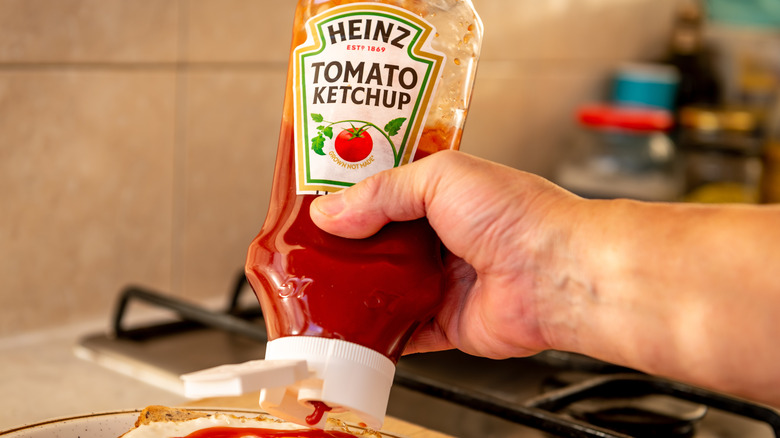You've Probably Been Squeezing Your Ketchup Bottle Wrong
Back in the heyday of the American diner, getting just a squeeze of ketchup for your fries was quite the taxing endeavor. This is largely because the condiment was stored in a right-side-up glass bottle that couldn't be squeezed at all. Instead, diners turned the bottle upside down, tapped the bottom, shook the container, and ... waited. And then waited some more. And waited a little longer until gravity finally took its course and allowed a modest amount of ketchup to pour out.
That all changed in 1991, when Heinz Ketchup called upon inventor Paul Brown for help, asking to incorporate his revolutionary valve technology into an all-new plastic squeeze ketchup bottle that could be stored upside down. The valve had previously proven its effectiveness in making shampoo bottles and leak-proof Gerber sippy cups for babies. Today, the "gravity bottle," introduced in 2002, is the default container for the condiment that most of us regularly stock in our fridge (since ketchup shouldn't be stored at room temperature long-term), but we probably take for granted the ease with which the bottle allows us to squirt the sauce onto our hot dogs or crispy ketchup fried rice.
And yet, as TikToker @jordan_the_stallion8 shared in a popular video, there's an even more shockingly efficient ketchup bottle technique many of us have been missing out on. By briefly squeezing the bottle from the sides, rather than by the front and back, and then letting go, air pressure will release the perfect dollop of ketchup — and spare you a hand cramp.
A deep dive into the science of gravity bottles
Today, squeeze bottles might seem simple — but in reality, they are a feat of engineering made possible by Brown's insistent desire to make the idea work. Persevering through the failure of more than 100 prototypes, Brown used the resources of his precision molding company and the help of his employee Tim Socier to create a silicone valve with slits. When pressure is put on it, the slits allow viscous liquids like ketchup or shampoo to come through. You've probably seen this before, without thinking much of it. That little X-shaped opening in the rubber on top of nearly every squeeze bottle is made according to careful specifications, so that squeezing either side releases the liquid, and as soon as you stop squeezing, the liquid stops flowing.
As TikTok user @jordan_the_stallion8 explains, squeezing the thin sides of the ketchup bottle briefly and then letting go works because the air pressure keeps the valve open for a little while even after you let go. Even if it's not exactly the intended method, the sideways squeeze is a fun party trick you can use — so long as the ketchup bottle is still full enough to have sufficient air pressure inside. There likely isn't so much air that it will continue flowing for longer than a few seconds, and as the bottle gets emptier, the trick may no longer work. If squeezing (from any side) still isn't getting your ketchup to come out, here's the answer to your pressing ketchup question: Shaking the bottle vigorously is your best bet for success.

